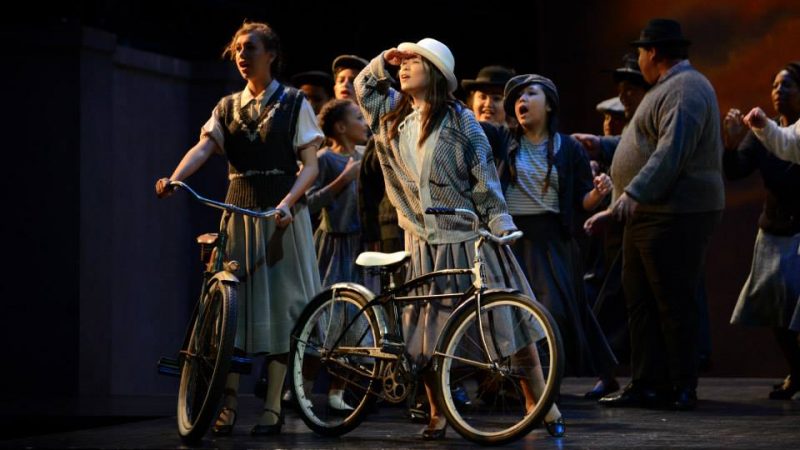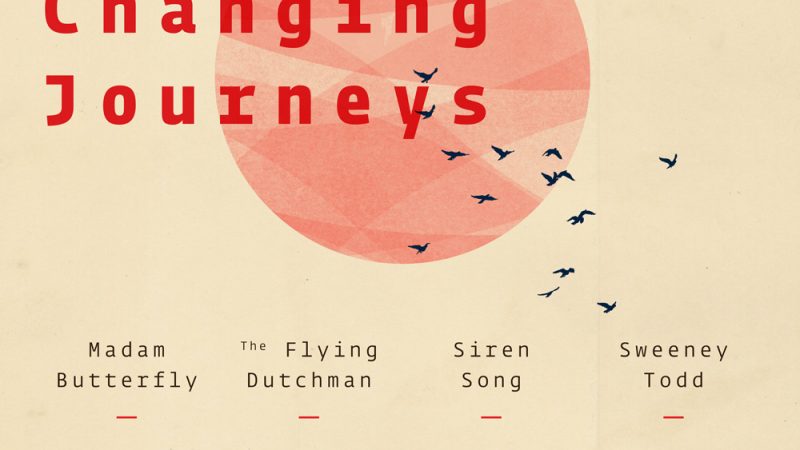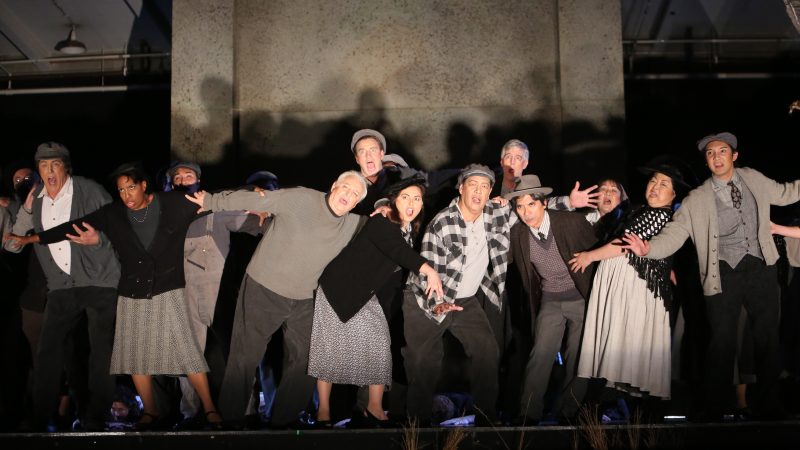Take a step behind the HOT Rehearsal Hall Doors and see just a sampling of all that ACT II has to offer!
ACT II starts this Friday (10a-6p) and continues over weekend on Saturday (10a-3p) & Sunday (10a-3p). Be there!


HOT is pleased to announced the creation of The Orvis Young Voices Studio program.
With generous support by the Arthur and Mae Z. Orvis Foundation, HOT is now able to offer programs to both adult singers in the Orvis Opera Studio and to young singers via The Orvis Young Voices Studio.
Young singers will have the opportunity to explore and develop in solo voice performances through group workshops, one-on-one opportunities, participating in and watching performances, and more!
For more information, contact the HOT Education and Outreach Team at youngvoices@hawaiiopera.org today!
To Audition:
It is with both happiness and sadness that we say Aloha to the Singers and BodyVox Dance Troupe who starred in HOT’s Pagliacci & Carmina Burana.
Until we meet again, Mahalo!
Click on the fun photos taken off-stage in the gallery below.

Hawaii Opera Theatre (HOT), the Islands’ only major operatic company, announces the 2014-2015 Opera Season (Download Brochure: 2014-2015 HOT Opera Season). For the first time in nearly 20 years, HOT is presenting four full-scale productions, including a contemporary opera in a new venue developed by Kamehameha Schools in Honolulu’s evolving Arts & Warehouse District of Kaka’ako.
Giacomo Puccini’s beloved and iconic Madam Butterfly opens the season on October 10, 12, & 14, 2014, directed by HOT Artistic Director, Henry Akina. Set in the mid-19th century, this tale of love and deceit follows the story of Cio-Cio-San (“Butterfly” in Japanese) whose romance with the American Naval Officer Pinkerton seems too good to be true. This timeless story has inspired audiences for centuries. Its popularity has seen spin-offs in film, television, and most notably, the Broadway musical Miss Saigon. This production was originally directed by Henry Akina at the Savonlinna Opera Festival in Finland, and follows HOT’s intention to bring great opera productions from around the world to local audiences.
Opera Season continues February 13, 15, & 17, 2015, as Richard Wagner’s The Flying Dutchman sails to the stage. This Wagnerian epic has captivated audiences for more than 150 years. Set along the Norwegian coast, legends tell of a ghost ship, The Flying Dutchman, captained by a man simply known as the Dutchman, whose curse is to wander the seas. His only chance comes once every seven years. Should he find a wife that will be true to him, he’ll be set free. The production was originally conceived at the Glimmerglass Festival in New York.
The nautical theme continues as a young sailor finds himself falling in love with a mysterious woman with one catch: they have never met. What begins as the experience of young love for the sailor evolves into a catfish scandal turned naval investigation. Find out what happens as HOT breaks new artistic ground with the contemporary opera Siren Song, written by one of the new generation of English composers, Jonathan Dove. This production will be under the stage direction of HOT’s award-winning Artistic Director, Henry Akina. Siren Song will run on March 20, 21, 27, & 28, 2015, and will be performed in one of the newly revitalized warehouses owned by Kamehameha Schools on Cooke Street.
For the final work of the 2014-15 Opera Season, HOT offers close shaves and meat pies as Stephen Sondheim’s darkly brooding tragedy, Sweeney Todd, is brought to life on the Blaisdell stage April 24, 26, & 28, 2015. Directed by Karen Tiller, the opera explores the revenge of one man, Sweeney Todd, the Demon Barber of Fleet Street, whose bloodlust is satisfied in a way that only opera can deliver.
Subscribe today by contacting the HOT Box Office at (808) 596-7858. From now through April 30, Season Subscribers can experience all four productions for as little as $120.

The world had become so used to “Cav & Pag” (the century-old pairing of Mascagni’s “Cavalleria Rusticana” with “Pagliacci”) that audiences had stopped thinking about either work in any depth. Together, they were the conventional, static example of late-19th-century “verismo.”
The new pairing, originally produced by Portland Opera in 1997 and re-created here for Hawaii Opera Theatre, vaults “Pagliacci” and “Carmina” into a new realm, offering a new perspective and highlighting their symbolism.
This production by Hawaii Opera Theatre and directed by Roy Rallo is a “must-see” for first-time opera-goers as well as for aficionados.
Although historically unrelated, and sharing only one scene, both works benefit from the juxtaposition: “Carmina” becomes a commentary on “Pagliacci,” and “Pagliacci” anchors the varied poems/scenes of “Carmina” as an example of how its themes unfold in life. Each deepens our understanding of the other.
The audience enters Blaisdell’s concert hall to face an open, curtainless stage dominated by the so-called “ghost light,” a single exposed bulb left lit on an empty stage whenever the theater is “dark” (not in use). The story begins with an explanatory prologue to set the tone, a character strolling casually on stage, asking, “May I?”
HAWAII OPERA THEATRE
“Pagliacci”/ “Carmina Burana”
Blaisdell Concert Hall
» 4 p.m. Sunday
» 7 p.m. Tuesday
Tickets $29-$120 at ticketmaster.com
“Pagliacci” (1892) is a play-within-a-play tale of love and jealous murder played out both by and among a troupe of itinerant actors.
That play-within-a-play theme is reflected throughout Allen Moyer’s stage design, with its half-walls, partial backdrops, stage lights in plain view, and a performance area demarcated on a raised platform on a stage, within a theater, on the theater stage of life. The audience remains continually aware of the interplay between drama and reality, comedy and tragedy, humor and violence, each pair two sides of the same coin.
In “Pagliacci” (“The Players”), each of the stock characters has multiple aspects: Pagliaccio is played by Canio, head of the troupe (sung for HOT’s production by tenor Kip Wilborn); Columbina is played by Canio’s wife, Nedda (sung by soprano Elizabeth Caballero); Taddeo is played by Tonio, the hulking fool (sung by baritone Louis Otey); and Arlecchino is played by Beppe (sung by tenor Nathan Munson).
Tellingly, it is easier to just forget all the names and roles, characters and traditions, and let the boundaries dissolve.
By the end, Nedda and her lover, Silvio, lie dead; Canio stands alone, his honor regained through murder but his love lost; and Tonio, having had his bitter, hopeless revenge, intones, “La commedia è finita” (“The comedy is finished”), referring to all meanings of comedy, play drama, the comedy of life, the comedy that means tragedy, Dante’s divine comedy, and so on.
“Carmina Burana” is not an opera at all but a genre-bending collection of orchestra-accompanied choral and solo songs on fate and the meaning of life, divided into three sections bound together by the chorus “O Fortuna” to the goddess of destiny at beginning and end. In this production, “Carmina” is staged through dance.
“Carmina” begins with the final scene in “Pagliacci” — the minimal, rustic setting that featured the troupe’s battered old truck transforms into a world turned on its side: The tree from “Pagliacci” swings up to tilt sideways, so the songs/dances play out in the space between the treetop and the “ever-changing moon,” a large white orb lit to reflect various moods.
The cast for both works was stellar.
“Carmina” was choreographed to spectacular effect by Jamey Hampton and Ashley Roland, who wove in themes immemorial from folk dance and the Garden of Eden, and was beautifully performed by BodyVox of Portland, Ore.. The impact was mesmerizing sensory overload, well worth seeing/hearing multiple times.
Caballero (also the soprano soloist in “Carmina”) was terrific, her large, clear voice soaring free as the birds she admires, making her characters dominant throughout.
Wilborn’s “Vesti la giubba” (the famous aria about laughing for the world while crying inside) did not quite have the power that makes the aria so very wrenching, but his lyric tenor, combined with his excellent acting, captured Canio’s internal macho conflict. Otey, physically menacing but with a dark, robust voice, made a surprisingly sympathetic villain.
Garland and Munson were excellent in “Pagliacci” but especially so in “Carmina,” when they had their major solos. Munson’s murderously high “roasted swan” song was the most striking: no one will ever forget its shadow-puppet technique with blood splattered across the screen and the image of being eaten.
The very active Chorus supplied a major role in both works, and the Kuho‘okahi Ensemble of the Hawaii Youth Opera Chorus, with their pure, crystalline tone, provided a musical highlight.
Conductor Hal France kept tight pacing and balance, and although the orchestra delivered lovely moments, especially in “Carmina,” articulation, intonation and ensemble were frequently rough. There were, however, noteworthy solos, including the flute solo for the circle dance in “Carmina,” which sounded like Susan McGinn.
The production lasts just over three jam-packed hours filled with charming nuances, including expert juggler Andrew Towl, choreographed jokes, and staging that evoked laughter or groans.
In the end, the lead singers are trampled by the choral crowd, which is then crushed by the wheel of fate, turning once again: “O Fortuna, velut Luna, statu variabilis …” (“Oh Fortune, like the moon ever-changing …”)
—-
By Ruth Bingham
Special to the Star-Advertiser / March 30, 2014